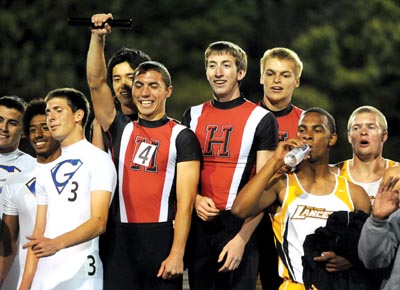After flunking as a hockey player at tiny Merrimack College, I
received an offer from the school’s public relations director:
Travel with the team, write stories about those Warriors for the
local newspapers and the program, get a work-study, paid, tax-free,
$60 a week. He launched a 30-year career, that guy, so the next
time you want to tell me I shouldn’t be in the business, tell him
instead. All his fault.
PHILADELPHIA
After flunking as a hockey player at tiny Merrimack College, I received an offer from the school’s public relations director: Travel with the team, write stories about those Warriors for the local newspapers and the program, get a work-study, paid, tax-free, $60 a week. He launched a 30-year career, that guy, so the next time you want to tell me I shouldn’t be in the business, tell him instead. All his fault.
I made a lot of friends with that $60. Players borrowed from it to eat, mainly, but it financed their dates occasionally, too. And yeah, beer.
This experience formed the opinion that follows. College athletes need to receive a stipend, and please save me the spiel about getting their education for free. As many athletes, coaches and administrators will tell you, education is a dangerous thing for revenue producers, to be watered down and generally avoided at all costs.
The NCAA says student-athletes are students first, athletes second. Not always. Really, not even often enough. The more income the student-athlete is responsible for generating, the more likely the equation is reversed.
As the story goes, Greg Oden arrived in Columbus interested in majoring in finance. He liked math. By the time March Madness arrived, he was taking two courses – Sociology and the History of Rock and Roll.
A real education can lead to ineligibility. And ineligibility can cost a school millions and millions of dollars, as The Ohio State University is about to find out.
Drafted first overall in the NBA draft after completing two trimesters, Oden wasn’t in Columbus long enough to get into the kind of trouble Terrelle Pryor got into, and as many as two dozen of his Buckeyes teammates may have, too, according to a story in this week’s Sports Illustrated.
The story asserts that Buckeyes players have been trading memorabilia for cash and prizes since Jim Tressel’s second season as coach, and that the coach often enabled those efforts, or looked the other way, or simply did not report them when he was made aware of them. Tressel, of course, resigned this week, months after he and school administrators insisted the incidences were isolated and not representative of the program.
To many inside and outside Columbus, Tressel always came across as someone with soul and scruples, which is probably how he has survived numerous incidences dating back to his days as coach at Youngstown State. The likely truth is that he had no problem with his players working outside of a system in which he could reward them only with playing time.
To be clear: The idea of paying athletes a little something for the effort will not cure all of big-time college sport’s ills. Boosters will always be around with cars and tattoos will always be available for memorabilia. If you want to cheat, you are going to cheat.
But a stipend would relieve some pressure on those who don’t want to go down that road. And make the NCAA, and its member schools, look just a little less like landowners from the 19th century South.
The argument that often follows this suggestion is this: Smaller schools don’t have the revenue streams larger schools do. This is why the stipend must be fixed by the NCAA or at least have limits. You might even model it after revenue-sharing in professional sports, building a general fund from a percentage of all revenue earned and spreading it equally among athletes, regardless of how much revenue their sport produces.
What a very collegial thing to do.
Value is not all about attendance figures and television contracts. Any time you see any college team in an airport, together at a mall, even as a line in the agate part of a newspaper, that’s advertising. And in an era in which the sticker price of even tiny Merrimack is just south of $50,000 a year, advertising is important. Representation is important. Image, too.
Think the idea of stipends is unrealistic? Fine, then think just a little outside the box here. How about an innovative undergraduate business program in which students pursue corporate funding or organize fund-raisers? I’m not the world’s greatest alum, but if I got a compelling pitch from a student seeking to fund the stipend of non-revenue-producing athletes, I would be more likely to write a check or sign up for a golf tournament.
Who knows? Maybe the program provides work-related experience that helps students land that first job.
Some people equate paying an athlete to corrupting athletes. It could work in reverse. A little something for the effort will not cure all of the corruption, but it may be more remedy than poison. And it’s the right thing to do.
— Column by Sam Donnellon, Philadelphia Daily News










